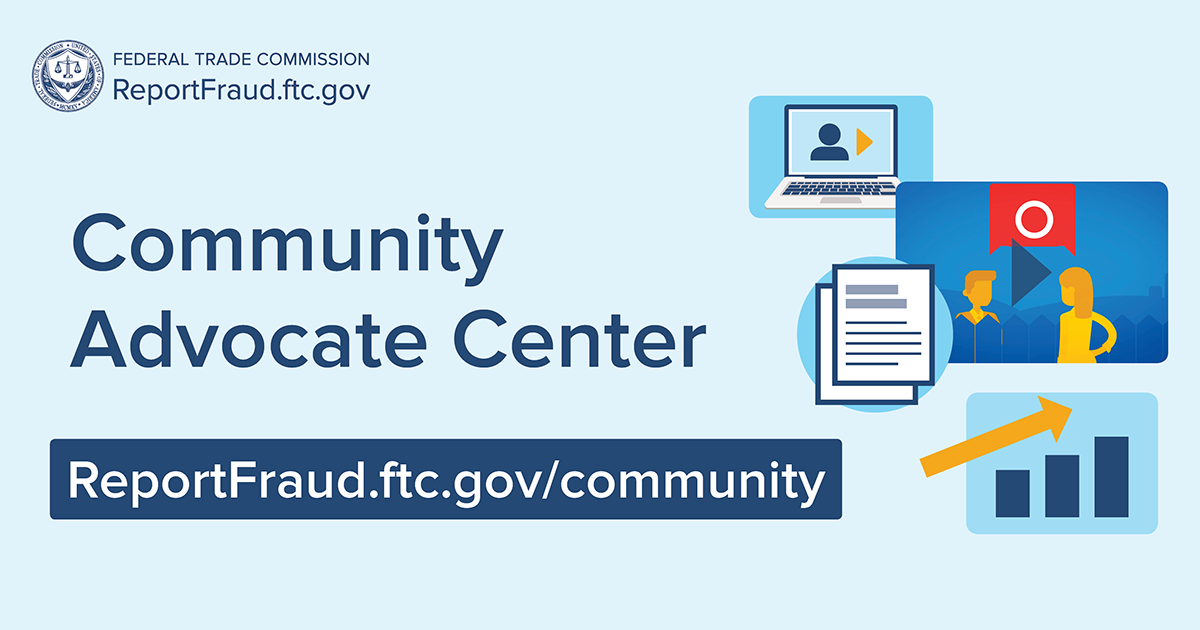When ReportFraud.ftc.gov launched in late 2020, it made telling the FTC about scams much easier. But here’s the thing: we know we’re still not hearing from lots of communities around the country. Not hearing those stories means we might not learn about the problems they experience, or bring cases to stop the bad practices and get money back. Which is, of course, always the goal.
But a new Community Advocate Center is aiming to address that. It gives community legal aid organizations a way to report fraud and bad business practices to the FTC — on behalf of their clients. These organizations that give people access to free and low-cost legal services often serve exactly the communities that the FTC wants to hear more from, including communities of color, speakers of other languages, and lower-income communities.
When advocates tell us people’s stories (or when people tell us directly), the FTC can give advice on next steps, including how to try to recover their money. For example, each year, people use their credit cards to pay scammers millions upon millions of dollars. That’s money people should usually be able to get back, and ReportFraud.ftc.gov tells people how.
If you know someone who works in a legal aid organization, please share this post with them. Send them to ReportFraud.ftc.gov/community to learn more. And tell them that the FTC would be happy to have them join Legal Services Corporation, Inc., the National Legal Aid & Defender Association, the National Consumer Law Center, and the National Association of Consumer Advocates in supporting this initiative.
Meanwhile, spread the word. If you’ve spotted a scam, tell the FTC at ReportFraud.ftc.gov.


In reply to The problem is your website by Sapejo
It helps when you report illegal calls, even if you think the caller used a spoofed number. We collect the numbers people report and release them each business day. This helps telecommunications carriers and other industry partners that are working on call blocking solutions. Read about how to stop unwanted calls at www.FTC.gov/calls.
Many call-blocking solutions rely on “blacklists,” which are databases of telephone numbers that have received significant consumer complaints. Blacklists are one way to determine which calls should be blocked or flagged before they reach consumers’ phones.
In reply to I was scammed out of $500. by Shattered2
You can report a scam or fraud to the FTC at www.ReportFraud.ftc.gov.
After you file your report, the reporting system tell you some steps to take that may help as you try to get your money back or stop a charge, depending on how you paid. The quicker you act, the better your chance of getting your money back. You also can find that information at ftc.gov/scams.
Read about how to get money back yourself, depending on the way you paid, on this page of Frequently Asked Questions.
In reply to I receive dozens of scams; by barbpower
The FTC can't take action on behalf of individuals, but it does process each report it gets. We use reports to investigate and bring cases against fraud, scams, and bad business practices. When you submit a report, we offer next steps you can take to protect yourself or recover from fraud. If you include your email address in your report, we'll also send you an email with these steps.
In reply to I have tried to forward scam by Christi B
We've made it easier to report the attempted frauds and scams you spot. You can report things you spot, even if you don't lose money. The FTC and other law enforcement agencies use reports for investigations.
When you go to www.ReportFraud.ftc.gov, click on Report Now, then click the button for the kind of scam you spotted, for example "An impersonator." Then, you will see a group of buttons to click, naming different kinds of impersonators. After you select the kind of impersonator you spotted, you'll go on to the next page, and see a big open text box.
You can copy and past a suspicious email into the text box.